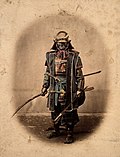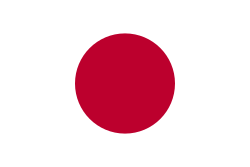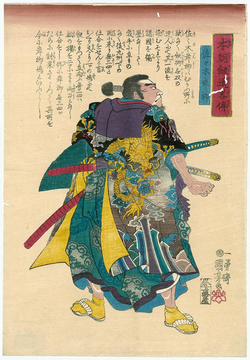The Azuchi–Momoyama period (安土桃山時代, Azuchi–Momoyama jidai) was the final phase of the Sengoku period (戦国時代, Sengoku jidai) in Japanese history from 1568...
30 KB (3,462 words) - 15:25, 20 March 2025
Azuchi Castle (安土城, Azuchi-jō) was one of the primary castles of Oda Nobunaga located in the Azuchi neighborhood of the city of Ōmihachiman, Shiga Prefecture...
17 KB (1,806 words) - 13:00, 19 May 2025
Azuchi (安土町, Azuchi-chō) was a town located in Gamō District, Shiga Prefecture, Japan. As of 2003, the town had an estimated population of 12,217 and...
2 KB (207 words) - 03:23, 17 April 2024
The Azuchi Screens (Japanese: 安土図屏風) are a set of six panel folding-screens depicting Azuchi Castle and its nearby town. Oda Nobunaga gifted them to Alessandro...
12 KB (1,179 words) - 02:07, 1 January 2025
The Azuchi religious debate (安土宗論, Azuchi shūron) took place between monks of the Nichiren and Jōdo-shū sects of Japanese Buddhism, at Jōgon-in near Oda...
8 KB (1,151 words) - 01:16, 26 March 2024
Oda Nobunaga (category People of the Azuchi–Momoyama period)
called the Azuchi–Momoyama period. The name "Azuchi–Momoyama" comes from the fact that Nobunaga's castle, Azuchi Castle, was located in Azuchi, Shiga; while...
172 KB (21,231 words) - 04:31, 21 May 2025
centimetres (29 in). Swords forged after 1596 in the Keichō period of the Azuchi–Momoyama period are classified as shintō (New swords). Japanese swords from...
68 KB (7,583 words) - 00:14, 22 May 2025
major role in the unification of Japan during the sixteenth century of the Azuchi–Momoyama period. The inner keep of Osaka Castle is situated on a plot of...
22 KB (2,435 words) - 07:25, 28 April 2025
Samurai (section Azuchi–Momoyama period)
military services. The Azuchi-Momoyama period refers to the period when Oda Nobunaga and Toyotomi Hideyoshi were in power. The name "Azuchi-Momoyama" comes from...
105 KB (12,899 words) - 21:48, 23 May 2025
Japanese castle (section Azuchi–Momoyama period)
Nobunaga was among the first to build one of these palace-like castles: Azuchi Castle was Japan's first castle to have a tenshu (天守, main keep), and it...
63 KB (8,779 words) - 05:53, 19 April 2025
unifiers of Japan. The name "Azuchi-Momoyama" comes from the fact that Nobunaga's castle, Azuchi Castle, was located in Azuchi, Shiga, and Fushimi Castle...
56 KB (5,671 words) - 04:27, 23 May 2025
Japanese architecture (section Azuchi-Momoyama period)
modest design as a counterpoint to the excesses of the aristocracy. In the Azuchi–Momoyama period (1568–1600), sukiya-zukuri style villas appeared under the...
91 KB (11,240 words) - 09:26, 8 May 2025
many other daimyō; his consolidation of power began what was known as the Azuchi–Momoyama period. After the death of Nobunaga in 1582, his successor, Toyotomi...
200 KB (16,488 words) - 06:46, 13 May 2025
Azuchi Station (安土駅, Azuchi-eki) is a passenger railway station located in the city of Ōmihachiman, Shiga Prefecture, Japan, operated by the West Japan...
5 KB (378 words) - 17:10, 12 March 2025
the lake from the Isaki Temple. Musa-juku Azuchi area Azuchi Castle, Special National Historic Site Azuchi-Hyōtanyama Kofun, National Historic Site Chōmei-ji...
11 KB (962 words) - 05:22, 14 April 2025
known as Kichō (帰蝶) was a Japanese woman from the Sengoku period to the Azuchi–Momoyama period. She was the daughter of Saitō Dōsan, a Sengoku Daimyō of...
24 KB (3,223 words) - 00:46, 2 February 2025
Muromachi period Ashikaga shogunate Nanboku-chō period Ōnin War Sengoku period Azuchi–Momoyama period Council of Five Elders Imjin War Early Modern Edo period...
18 KB (369 words) - 22:41, 14 April 2025
commander of the Western army in the Battle of Sekigahara following the Azuchi–Momoyama period of the 16th century. He is also known by his court title...
27 KB (3,235 words) - 03:53, 5 May 2025
8, 1600) was a Japanese samurai and daimyo of the Sengoku-through late-Azuchi–Momoyama periods, who served Tokugawa Ieyasu. Torii died at the siege of...
13 KB (1,474 words) - 15:37, 6 May 2025
Emperor Ōgimachi (category People of the Azuchi–Momoyama period)
between the Sengoku period of the Muromachi bakufu and the dawn of the new Azuchi–Momoyama period. His personal name was Michihito (方仁). Ōgimachi was the...
13 KB (1,137 words) - 22:36, 20 April 2025
battlefield, they were often made with molded, lacquer-coated paper. In the Azuchi–Momoyama period, tosei-gusoku kabuto had a simple, bold design in accordance...
20 KB (2,030 words) - 15:55, 20 April 2025
kozane. Azuchi–Momoyama or Edo period, 16th–17th century, Tokyo National Museum Akechi Hidemitsu's Nanban dou gusoku (western style gusoku), Azuchi–Momoyama...
45 KB (4,846 words) - 16:18, 14 May 2025
tradition, owing to the enduring popularity of the tea ceremony. During the Azuchi-Momoyama period (1573–1603), kilns throughout Japan produced ceramics with...
52 KB (5,061 words) - 02:38, 3 December 2024
overlaps with the Muromachi period. The Muromachi period is succeeded by the Azuchi–Momoyama period (1568–1600), the final phase of the Sengoku period, and...
25 KB (3,170 words) - 17:24, 4 May 2025
April 13, 1612) was a Japanese swordsman who may have lived during the Azuchi–Momoyama and early Edo periods and is known primarily for the story of his...
7 KB (596 words) - 02:56, 12 May 2025
Komatsuhime (category People of the Azuchi–Momoyama period)
(小松姫) (1573 – March 27, 1620) was a female warrior (onna-musha) during the Azuchi-Momoyama period and early Edo period. Born the daughter of Honda Tadakatsu...
6 KB (485 words) - 22:35, 20 April 2025
yakko (旗本奴) were gangs of samurai in feudal Japan. First appearing in the Azuchi–Momoyama period (between the end of the Muromachi period in 1573 and the...
5 KB (478 words) - 23:53, 4 May 2025
Gamō merged into the city of Higashiōmi. On March 21, 2010 the town of Azuchi merged into the city of Ōmihachiman. Light blue autonomies are Gamō District's...
8 KB (144 words) - 13:41, 7 May 2025
Nakamura (bandit) (category People of the Azuchi–Momoyama period)
Nakamura Chōbei (中村 長兵衛) was a bandit peasant during the 16th century Azuchi–Momoyama period in Japan. He was the leader of a gang of bandits that were...
2 KB (163 words) - 22:35, 20 April 2025
Wagashi (section Sengoku and Azuchi-Momoyama period)
with a zarame (ザラメ, coarse sugar) center. From the Sengoku period to the Azuchi-Momoyama period, wagashi developed along with the Japanese tea ceremony...
31 KB (3,376 words) - 13:03, 27 April 2025

























